Neck traction, also known as cervical traction, is a popular and science-backed neck stretching method to relieve neck pain for anyone suffering from neck arthritis, herniated/bulging discs in the neck, neck strains, and cervical muscle spasms.
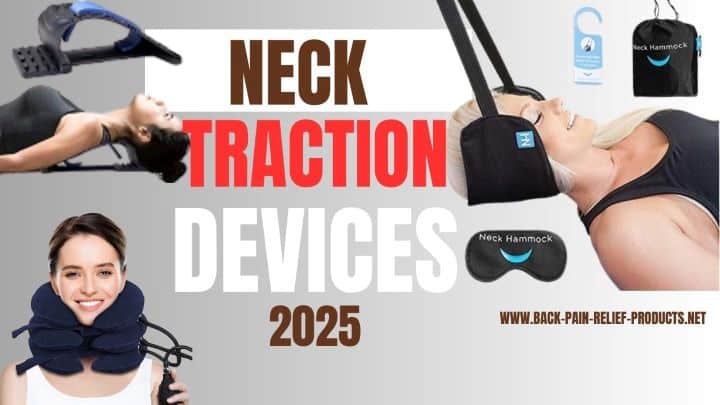
Traditionally performed by chiropractors, cervical traction can also be done at home using safe and effective neck traction devices.
These devices work by applying a gentle pulling force to the neck, creating space between the vertebrae. This can relieve pain, improve flexibility, and promote healing.
Plus, it’s way gentler on your wallet than those weekly appointments.
We’ve researched and found the top neck stretchers (cervical traction devices) in 2025.
In a Hurry?
If you’re in a hurry, here are our top-recommended neck stretcher devices right now.
Below you’ll find our full neck stretchers reviews.
This post may contain affiliate links at no extra cost to you.
Overview
Can a Neck Stretcher Actually Help?
Short answer: Yes. A 2017 study found that mechanical cervical traction significantly reduces neck pain both immediately and over time. From my experience, using a good neck traction device can help with:
- Herniated or bulging discs
- Pinched nerves
- Neck stiffness and muscle pain
- Headaches
- Arthritis and degenerative disc disease
The best part? You get relief without medication or surgery.
Home neck traction units (and cervical pillows) gently stretch the spinal vertebrae and muscles.
This immediately relieves the pressure on the discs and the nerves.
Now everything is in place, and the awful pain and stiffness can be dramatically reduced.
All of this is done without medication and unnecessary surgeries.
How Does a Neck Stretcher Work?
With cervical traction devices, the goal is to allow your neck muscles and pinched nerves to be released.
Tension is placed on the head to pull it up and away from the neck, stretching the muscles and ligaments around the spine’s vertebrae and expanding the space between the vertebrae.
Cervical Traction Types & The Best Neck Stretchers
You can choose from 5 types of neck traction home devices.
They can get you about the same results, but they are somewhat different.
These include inflatable neck stretchers, orthopedic (arched) neck stretchers, over-the-door neck stretchers, neck traction slings, and cervical posture pumps.
1. Inflatable Neck Stretchers (Air Traction)
Best for budget-friendly, on-the-go relief
VIEW ON AMAZON $27
Air neck traction devices look like stacked travel pillows and are basically inflated neck braces.
They are fully adjustable: You pump them up to lift your head and take pressure off your spine.
I found them super easy to use and great for travel, but some lower-quality ones leaked air quickly.
✅ Portable and easy to adjust
✅ Can be used while sitting or lying down
❌ Some models put too much pressure on the jaw
Best Pick: The Crabclaw Inflatable Neck Traction Device ($27 on Amazon) – It has a quick-release valve in case you overinflate.
The Best Inflatable Neck Stretcher
The Crabclaw inflatable neck traction device ($27 on Amazon) helps align your cervical spine, correct your posture, and stretch your spine and neck muscles, which alleviates neck pain and helps heal bulging discs, pinched nerves, neck arthritis, and degenerative discs.
We also like the unique safety feature that allows you to quickly deflate the device if you accidentally inflate it too much.
Dr. Adam J. Story, a chiropractor with 24 years of experience, recommends inflatable neck braces for his patients because they are less aggressive and perfect for people who need neck support after a mild injury.
2. Over-the-Door Neck Traction Kits
VIEW ON AMAZON $17
Best for deep traction at home
These use a pulley system to gently stretch your neck. They take a little setup (and a sturdy door), but once in place, you can sit and let gravity do the work.
The neck puller device requires you to place straps around the back of your head and your chin (see the picture above), which then attach to a counterweight.
✅ Provides strong traction
✅ Adjustable weight for personalized relief
❌ Less portable, requires a door and chair
Best Pick: DMI Over-the-Door Neck Traction Kit ($16 on Amazon) – Sturdy, easy to adjust, and budget-friendly.
The Best Over-the-Door Traction Device
The DMI Over-the-Door Neck Traction Kit ($17 on Amazon) is made with a sturdy metal bracket, is safe to use, and the calibrated weight bag allows you to vary the pressure on your neck (2-20 pounds) for quick and effective neck pain relief.
The adjustable head fits most people.
It is a cost-effective cervical traction unit and comes with everything you need, though we recommend you check with your physician for the amount of counterweight and usage time for your specific needs.
3. Neck Stretcher with Heat
Best for relaxation and stiffness relief
VIEW ON AMAZON $27
These combine gentle traction with heat therapy (to increase blood circulation), which felt amazing after long workdays. Simple to use – just lie on it for 5-10 minutes.
You just turn it on for 3 minutes before you fall asleep, and then lie your neck on it for 5-10 minutes. It stretches your neck and heats the area, which feels very relaxing and even helps you fall asleep quickly, pain-free.
✅ Helps relax tight muscles
✅ Promotes blood circulation
❌ Feels a little rigid at first
Best Pick: Heated Neck Stretcher ($27 on Amazon) – Three heat levels and a comfortable design.
It is odorless, it heats up quickly, and it comes with a little bag to store. The cover is removable and machine-washable.
It feels a bit rigid at first, but after a few days, it will feel more natural, and the effect will kick in.
4. The Neck Hammock (Neck Traction Sling)
Best for compact, easy use anywhere
VIEW ON AMAZON $39
This simple device lets you lie back while it cradles your head and stretches your neck. I found it very relaxing, but it took some trial and error to position it correctly.
The neck hammock creates neck traction by pulling your head away from your shoulders.
This makes your neck muscles relax and relieves the pressure on them effectively.
It also slightly expands the space around your neck vertebrae, which allows for more blood flow (and oxygen!) to the area.
✅ Great for relieving tension headaches
✅ Small and portable
❌ Requires a sturdy hook or surface to attach it to
Best Pick: Original Neck Hammock ($39 on Amazon) – It’s Well-designed and holds up better than cheaper knock-offs.
The only con is that you have to move a bit forward on the floor to start feeling the traction.
DIY Neck Hammock
A lot of people have asked us whether it’s possible to make your own neck hammock.
The answer is yes. All you’ll need is a good towel and a rope.
But we want to warn you: you have to do this the right way, since any “malfunction” may cause you to bang your head on the floor. We recommend buying a professional neck hammock and not taking a chance.
Instructions:
- Fold your towel three times to narrow the length and width and to create a base for your head.
- Create two holes on each side of the towel to create a loop, and slide the rope between the two holes.
- Your neck hammock is ready. Now you need to find a sturdy base to tie the rope to, like a doorknob.
- Once you’re done, just rest your head on the hammock.
Here’s a video with a good demonstration:
5. Cervical Posture Pumps (Disc Hydrators)
Best for long-term posture correction
VIEW ON AMAZON $320
These are more expensive but mimic professional chiropractic traction. If you have chronic pain, a posture pump might be worth the investment.
They simulate cervical traction performed in a clinic and are nearly identical as far as the quality of treatment goes.
You simply lie down, adjust the little knob/posts that secure the base of your skull, and place the strap on your forehead. Then you just pump up the pressure and tighten.
✅ High-quality, long-lasting device
✅ No air leaks or pressure on the jaw
❌ More expensive and takes up space
Best Pick: ComforTrac Cervical Traction ($320 on Amazon) – It has Adjustable angles and up to 50 lbs of force.
Posture pumps are usually a bit pricier, but they can be worth their price when it comes to neck pain healing and recovery.
The Best Posture Pumps
Here are our two most recommended posture pumps for 2025:
1. ComfortTrac Cervical Traction
The ComforTrac posture pump is a durable and sturdy neck traction device that is easy to use and comfortable, and many users report immediate results after using it.
This top-of-the-line cervical traction kit supplies up to 50 pounds of force and has an adjustable incline angle of 10, 15, or 20 degrees.
See our detailed Comfortrac Cervical Traction Review
Posture Pump Alternative
If you’re not sure about posture pumps, consider using an inversion table.
See our full comparison between the posture pump and the inversion table to decide what’s best for your needs.
2. Saunders Cervical Traction Home Unit
The Saunders has a handheld pump with a pressure relief valve for easy adjustment of traction force, and it applies up to 50 pounds of traction force and has adjustable angles for a personalized experience.
See our full review of the Saunders Cervical Traction.
We also recommend…The Cervical Posture Pump
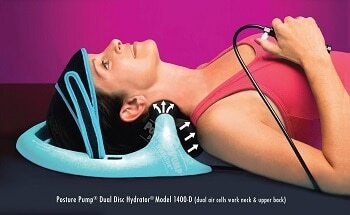
See our detailed review of the Cervical Posture Pump
6. Orthopedic Neck Stretchers
Best for posture correction and mild pain relief
VIEW ON AMAZON $20
These work like orthopedic back stretchers, but for your neck. They’re simple and effective, but don’t provide as much traction as other options.
It only requires 5 minutes of daily treatment to get long-term results such as neck stiffness relief, migraine relief, and cervical decompression for bulging/herniated discs.
✅ Affordable and easy to use
✅ No setup required
❌ Limited stretch compared to other devices
Best Pick: RESTCLOUD Neck Stretcher ($20 on Amazon) – It has Adjustable settings and supports up to 330 lbs.
Can a Neck Stretcher Help Your Upper Back Hump?
Neck stretchers are designed to alleviate neck pain and improve posture. They may be beneficial for conditions such as forward rounding shoulders, also known as kyphosis, and neck hump or dowager’s hump.
They can help by temporarily restoring the natural curvature of the cervical spine, which relieves tension and stress and improves blood circulation. And if you use them consistently, you may experience long-lasting results.
However, if you suffer from a severe case of kyphosis, you may not experience significant results. A neck stretcher should be an add-on to regular exercises to strengthen and lengthen your neck muscles.
Cervical Traction Device Side Effects
Generally, performing cervical traction is safe, but remember that results differ for different people.
The treatment should be pain-free.
If you feel pain, you are overdoing it, and this aggressiveness may lead to further damage and pain.
However, neck decompression is not recommended if you’ve already had neck surgery.
Do not overdo traction because it can cause more harm than good and overstretch your neck.
We recommend following the instructions carefully and asking your doctor for treatment time and frequency.
Possible side effects of neck traction are headache, dizziness, and nausea. If you feel any of these, stop treatment immediately.
Consult with your doctor before you start treatment if you have:
- Recent injury in the neck area
- A bone infection
- A known cervical tumor
- Osteoporosis/rheumatoid arthritis
- Cervical instability
- Spinal hypermobility
How to Do Neck Traction at Night
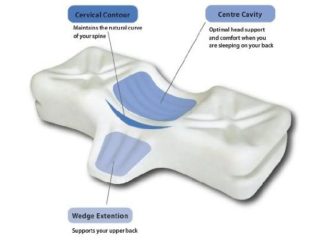
If your sleep position mostly causes your neck pain and usually comes at night or in the morning, a neck traction pillow can be very helpful.
Cervical pillows are designed to provide support and help maintain the natural curve of the neck, which can reduce discomfort and improve mobility.
They work by providing gentle traction and support to the neck, and many users have reported relief from neck pain and improved sleep quality.
See our post about how to choose the best pillow for neck pain.
To your health and happiness,
The Back Pain Relief Products Team
Studies
Intermittent Cervical Traction for Treating Neck Pain: A Meta-analysis of Randomized Controlled Trials, SPINE. 42(13):959–965, JULY 1ST, 2017, doi: 10.1097/BRS.0000000000001948
International Journal of Athletic Therapy and Training, v. 22, issue 5, p. 4-11
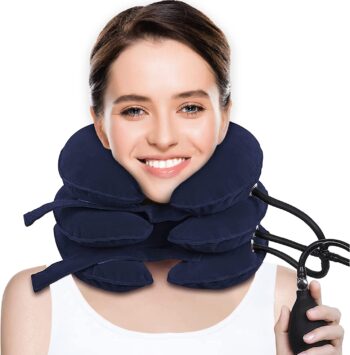
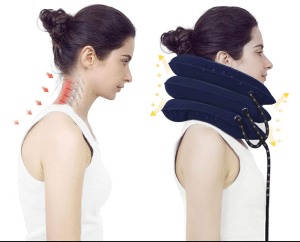
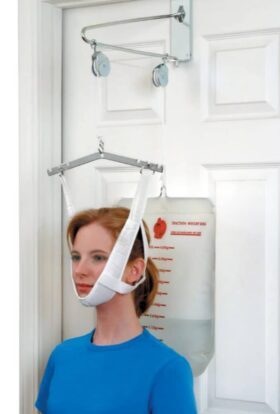
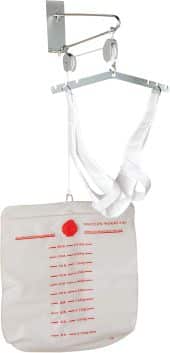
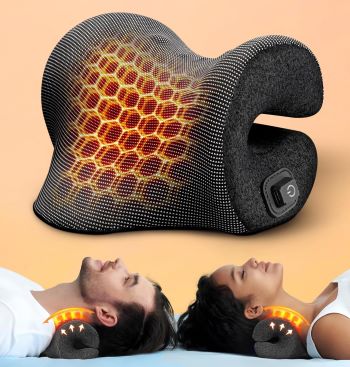
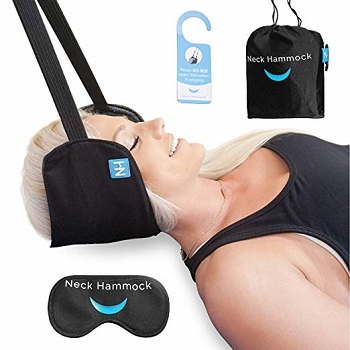
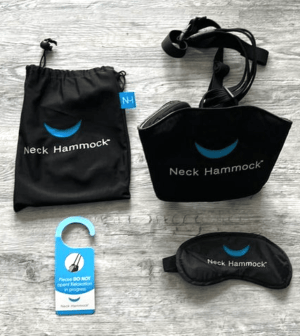
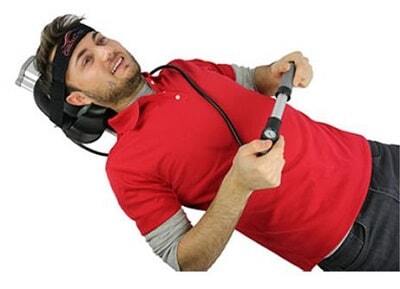
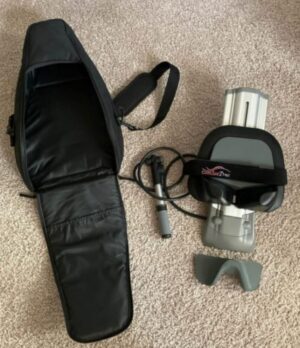
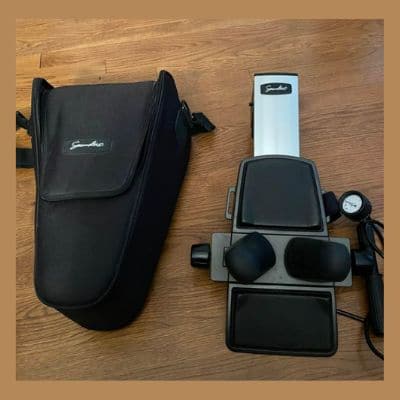
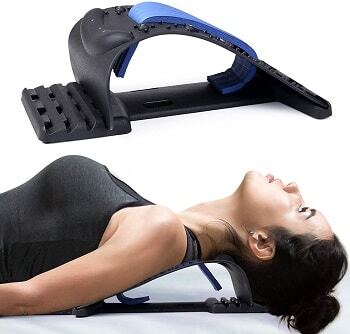
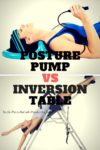

Hello..
I’ve suffered from chronic migraines for 25+ yrs, I had a bad fall on ice 10 yrs ago & my neck has been in constant pain since then. I then went thru breast cancer 4 yrs ago on the L side & shortly after had shoulder surgery on the L side…did I mention I’m L-handed?. Since the cancer I also have osteoporosis & bone density loss & have to sleep in a recliner as I cannot lay flat, is there a way to use neck traction while slightly reclined?. I hope you may have suggestions.
Thank you
Inflatable neck traction (like the Chisoft mentioned in the post)can be used while reclined. But I would check with my doctor first to be on the safe side.
I have a neck traction device that I used a few years back that consists of a head harness attached to a rope that is routed thru 2 pulleys over a stanchion — and on the backside of the stanchion you add small weights to pull on the rope. You lie down with your head close to the stanchion and the rope pulls upward on your head harness (a chin strap and a strap around the back of your head). But I can’t remember how close to the stanchion my head should be. Can you tell me approximately at what angle it should pull on the head harness (assuming that if it were pulling straight upward it would be at a 90-degree angle with respect to a line drawn thru your body & head**)?
**I assume it would be a similar angle as for one of the door-knob units, but I don’t know what angle that is.
Nicely written. Thanks for writing this. I hope it helps a lot of people with neck issues.
Can you briefly explain why the Comfortrac is your higher recommendation over the Saunders? Price aside, other reviews I’ve read seem to prefer the Saunders.
In my opinion, the Comfortrac and Saunders are quite similar, if not completely the same. However, the Comfortrac comes with a lower price tag (usually) and the Saunders tends to “disappear” from the stores and appear back again every few months, so I don’t know if I can trust the company. Overall, this is why I prefer the Comfortrac, I hope this helps :)
I Want a device that hangs over the bed; I lie on my back with my head and neck in a saddle that is in a slot, and a bungy-type cord slowly pulls on my neck muscles. I used to have one years ago, lost track of it.
The water bag system is cheap and easy! I sleep in a recliner in traction every night and my herniated disks are improving. Seven – eight hours per night works great with a nine pound pull.
I have a Comfortrac Cervical Traction device. I used it a few years ago on a pinched nerve. It worked great. My wife is a long-term sufferer of Trigeminal Neuralgia (TN). TN is a problem with the fifth cranial nerve and blood vessels. mostly emitting from the brain stem area. Of the many procedures and medications, she had with little help she has had some success with Upper Cervical Care (Blair Technique). Much of what I see the technician do is mild manipulation of the neck area, attempting to relieve pressure off the nerves and to allow full blood flow.
My question is this: Have you ever heard of anyone suffering from TN that may have used this device to help relieve TN pain? It appears to be used in a very close way the Upper Cervical Care technician pulls and manipulates her neck. Thanks for your time!
I haven’t heard about it but I would definitely ask a chiropractor or a physical therapist about it. They are familiar with many cervical traction devices.
Years ago, we used cervical traction to relieve symptoms of what is commonly called ‘pinched nerve’ or ‘slipped disc’. As the cost of hospitalization increased, they stopped this and tried to treat it with medications. When I finally had pinched nerve pain going down the backs of my arms, the doctors’ medications did nothing. I created a similar ‘over the door’ device and had relief in minutes. It took several days of using it for the pain to disappear completely. I’ve had three recurrences over the past 20 years, but each time, the cervical traction resolved the problem. I’m glad that they finally make something that can be purchased so the public can get relief from this without taking medications. Great article! Keep up the good work.
Thanks Don for sharing your experience with us and for your feedback! :)
Just wanted to share that there are several stretching exercises one can do to help relieve several different types of neck issues. Good posture is a must. I did the water bag door contraption for several years which helped avoid surgery. I was under an orthopedic doctor’s care. Age has caught up and I’m hoping for traction instead of surgery. Thanks for the great information. It gives me something to discuss with my Neurosurgeon.
Another consideration that you may want to try is The Neck Hammock. Designed by a Physical Therapist, provides the same cervical traction force as the pump units(yet 1/4 the price), eliminates TMJ aggravation, is portable, and very comfortable. It will launch at the beginning of the year. This in no way is intended to spam, I truly believe it’s the next breakthrough technology for at-home cervical traction. The Website is: TheNeckHammock.com
Steve, good luck with your new product. :)
ok…first time …I got a headache which stopped when I removed it…did I have it on too tight
Yes, probably. Go slow.
Let me know how it goes.
Hi, do you have any recommendations for how often and how long to do neck traction?
Rebecca,
To my knowledge, you can do neck traction every day (if you’ll need it), and all you need is a few minutes (3-7) to feel relief. Once you feel relief, you stop.
Listen to your body, it will tell you the point of the most comnfortable stretch and when to stop.
Good luck!
I had 3 herniated discs in my neck, c5 c6, and c7 that I had surgery on. I now have a metal plate and 6 screws in my neck. I recently found out I have a bulging disc between my c3 and c4. My surgeon recommended a traction device. My neurologist on the other hand told me that there’s a nerve that runs quite deep under the collar bone and any type
Of therapy (traction or not) would probably put me in a whole new world of hurt. What do you think?
Sarah,
Why don’t you go back to your surgeon and tell him about what the Neurologist told you? Confront both of them with what they’ve said and then think about it, and do what your gut feeling tells you. Obviously, my opinion about this won’t be more important than two doctors…
I appreciate your concise explanation of neck traction devices. I have been leaning toward a posture pump, although I did not know what it was called. My lower back always responded well to traction, so I have hopes for relief from neck traction. I have TMJ and think the over-the-door and pillow devices might aggravate it. You have given me enough information to approach my chiropractor for additional advice.
Kitty,
Glad to help…
I hope you feel better soon!:)
Are there any exercises one can do for neck pain depending upon one’s ailment?
The best exercises for neck pain are, in my experience, neck traction exercises.
You can find them on YouTube easily.
I am very interested in reading your detailed reviews of both the Comfortrac Cervical Traction and the Cervical Posture Pump; however, when I click on the link, it takes me to reviews of cervical pillows. Please correct this hyperlink issue and/or email me the reviews. Thank you!
Janet,
That’s strange…I’ve checked the links and they’re fine…
But I’m emailing you right now with the links anyway.
I hope this helps!:)
Thank you so much for taking the time to post this. I am in Korea and was intimidated when my local clinic physician said the word “traction”. Now that you have shown me what she meant, I am more confident that a good solution is at hand.
Natalie,
I’m glad this put your mind at ease. Traction is one of the best alternative methods to treat neck pain and is highly effective in my experience…
Good luck!